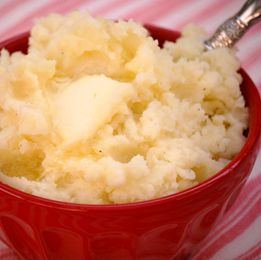Yup, it’s mashed potato time! Say what you will about the fat and richness of this oh so American dish but who doesn’t love a good, sizable dollop of mashed spuds?!
Want to know how to make mashed potatoes that are worthy of a feast?
Read on for tips and links to great info that’ll help.
#1) Remember it’s all in the potato.
Russets are the kind most of us are accustomed to using. However, most chefs and cooks have moved away from the russet of yore and are now opting for Yukon Gold. The difference? Yukon Golds have medium water and starch content and “most people prefer the flavor and golden color.” Nevertheless, high-starch-content russets are said to give the creamiest mash if done perfectly. So there’s a larger margin of error if you opt for the russet, less so if you go with the Yukon. Knowing how stressful if can be cooking during the holidays, I know which variety I’ll be plopping into my grocery cart.
#2) Don’t let the potatoes sit after boiling.
Okay, this tip comes down from my aunt. I’ve put it to the test myself and have found she’s spot-on. Potatoes tend to become gluey if you let them rest after boiling. So, have your ricer or masher ready to go and get that butter, milk or half and half melted if that’s what your recipe calls for. Timing is your friend when it comes to making great mashed potatoes.
#3) Dry them off.
Excess moisture on boiled potatoes can also result in a gluey texture. You can use tongs and a sterile dishcloth or paper towels that do not have strong paper scent to dab up excess moisture. Another common trick is to simply return the cooked potatoes to the same pot they were boiled in. Heat this already hot, empty pot on medium heat and turn potatoes, piece by piece, to cook off excess moisture. Takes approx. 1-2 minutes.
#4) Add the butter first.
Thanks to America’s Test Kitchen we know when you add the butter first, the potatoes absorb the molecules, yielding a buttery result. When you add the milk or half n’ half first, the potatoes soak up the milk and the butter remains on the outside, giving you milky or grainy mashed potatoes. So, butter goes in first!
#5) Start with cold, salted water
Start your potatoes in cold, salted water and heat on medium high until boiling then reduce to simmer. Potatoes are done when you can pierce with a fork with almost no resistance. The salt becomes absorbed into the potatoes and though this is debatable, raises the boiling temp slightly, resulting in creamier potatoes. If you just tossing potatoes into already boiling water will cause the outer starch granules of the potatoes to gelatinize on contact with the water which will block the water from penetrating deeper into the potato. Over boiled potatoes have too much water and will be soggy and unable to soak up the butter you add when you mash. More here.
#6) Use the right tools.
Consensus is that no electric masher, processer or mixer can do the job your hands can do so plan on sweating it out. A rice or potato ricer is the tool of choice amongst chefs and many cooks. Second to that a grid or crisscross masher is preferable to the one that has a bunch of lines that run parallel to one another. Parallel lines in your masher will mash less surface area and can lead to over-mashing. Learn more at this link.
Now for those of us who love mashed potatoes and want to make a less fattening version of the side, I’ve included a link below to a new recipe for sensible, very low fat mashed potatoes courtesy of Fitness Magazine. I would disregard some of the preparation instructions and apply the tips and see how it comes out. I’m going to put it to the test shortly, opting for just a tablespoon or two of butter, then olive oil and the sour cream, etc. Low fat Mashed Potatoes.
Happy Eating!





